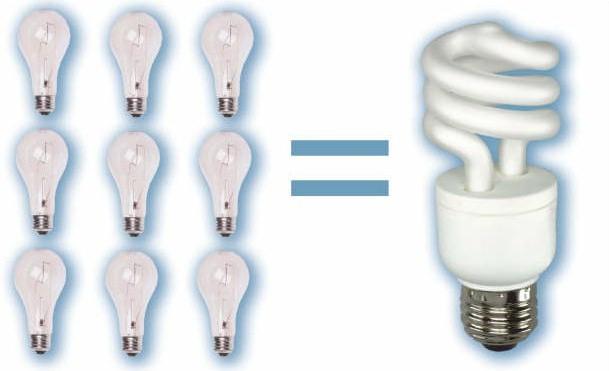The lighting industry is developing rapidly. It seems that recently energy-saving bulbs have appeared. Initially, consumers were repelled by their high price, the presence of mercury, an unusual shade of light. Now they are used everywhere, and in Europe ordinary incandescent lamps are already completely difficult to find. How are they good and how different are they from their predecessors?
Firstly, the name “energy-saving light bulbs” is just a publicity stunt. In fact, the "housekeeper" is a well-known fluorescent discharge lamp for a long time . In total, there are two types of such lamps: compact integrated and not integrated. They differ from each other only in the presence or absence of an electronic starter. Integrated ones have a built-in starter and they are usually equipped with a base that allows you to use them instead of incandescent lamps. Non-integrated lamps do not have an electronic starter and can only be installed in the lighting fixtures in which it is integrated (table lamps, for example).

However, the history of the name and the technical subtleties of the construction are hardly of interest to the consumer. For him, the quality of light, reliability and cost-effectiveness of the product are important. But this is where the most doubt and debate arises. After all, energy-saving bulbs are significantly more expensive than ordinary incandescent ones, and many are asking: "Will such a purchase be justified?" Let's try to figure it out.
Energy-saving bulbs being, as already mentioned, gas-discharge, they consume 3-5 times less energy per unit of light than conventional incandescent lamps. Meanwhile, the built-in electronics (starter) makes them more sensitive to voltage surges and frequent on-off. In most cases, the manufacturer, calculating the number of working hours of an energy-saving lamp, assumes that it will turn on and off once a day. This explains the fact that the service life of such lamps in offices is two, three times longer than at home. In addition, you should know that an energy-saving light bulb has a so-called burn-in period (reaching the brightest glow), which occurs only after 100-200 hours of burning. After that, the brightness decreases and in a year can decrease to 70% of the declared. And yet, if an energy-saving bulb lasts at least a year, it will fully pay for itself, both in terms of energy saving and in terms of the required number of incandescent lamps that will have to be bought for the same period. For comparison: the service life of a 60 W incandescent lamp, according to manufacturers, is no more than 1000 hours. And the lamp of energy saving 20 W has a guarantee for 4000 hours.

As for the quality of light, modern energy-saving bulbs are much superior to their predecessors in terms of color rendering and color. In expensive fluorescent lamps , a five-band phosphor is used, which makes it possible to bring artificial light as close to daylight as possible.
In addition, thanks to modern technology, it has become possible to make fluorescent lamps with any color, from yellow to ultraviolet. However, all of the above applies only to expensive (from $ 5) models. A cheaper energy-saving light bulb does not live up to expectations, as it gives a "bad light", and the low-quality components used in it rarely allow it to serve for more than a year.